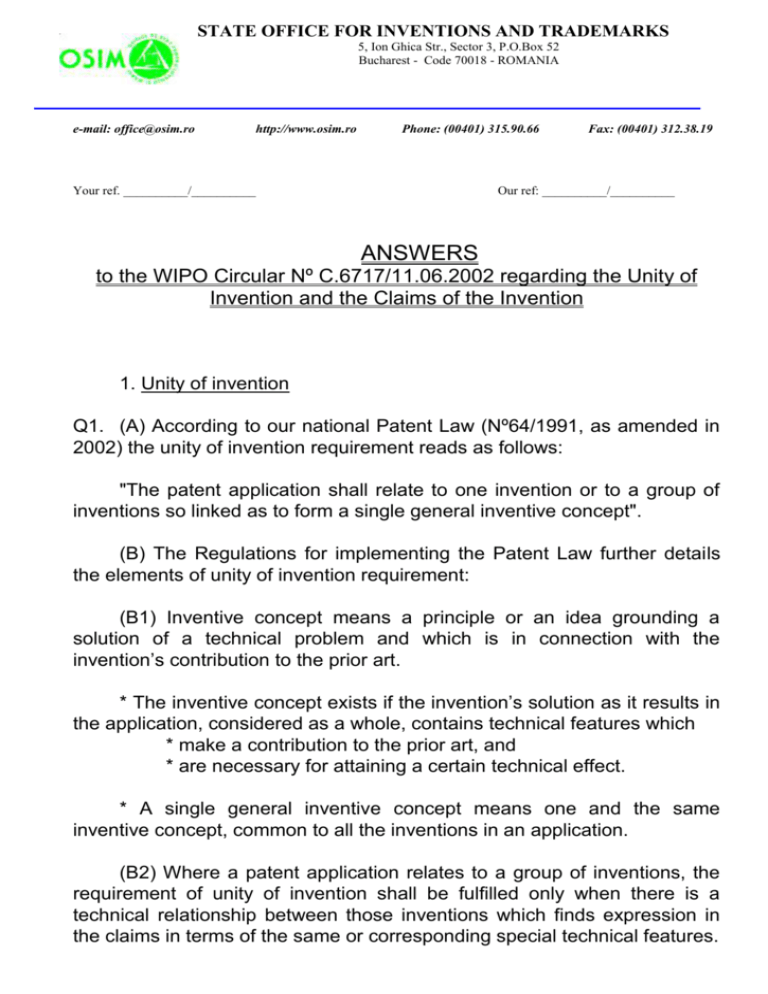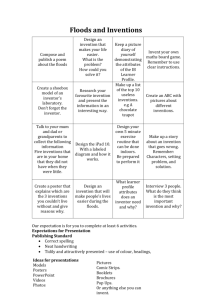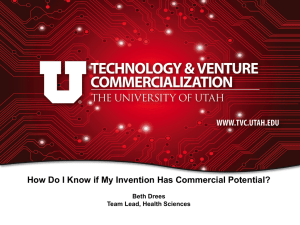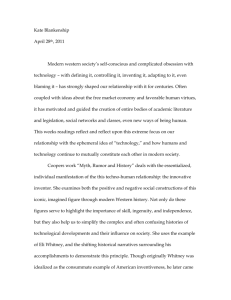Comments re SCP Working Group, 2nd session
advertisement

STATE OFFICE FOR INVENTIONS AND TRADEMARKS 5, Ion Ghica Str., Sector 3, P.O.Box 52 Bucharest - Code 70018 - ROMANIA e-mail: office@osim.ro http://www.osim.ro Phone: (00401) 315.90.66 Your ref. __________/__________ Fax: (00401) 312.38.19 Our ref: __________/__________ ANSWERS to the WIPO Circular Nº C.6717/11.06.2002 regarding the Unity of Invention and the Claims of the Invention 1. Unity of invention Q1. (A) According to our national Patent Law (Nº64/1991, as amended in 2002) the unity of invention requirement reads as follows: "The patent application shall relate to one invention or to a group of inventions so linked as to form a single general inventive concept". (B) The Regulations for implementing the Patent Law further details the elements of unity of invention requirement: (B1) Inventive concept means a principle or an idea grounding a solution of a technical problem and which is in connection with the invention’s contribution to the prior art. * The inventive concept exists if the invention’s solution as it results in the application, considered as a whole, contains technical features which * make a contribution to the prior art, and * are necessary for attaining a certain technical effect. * A single general inventive concept means one and the same inventive concept, common to all the inventions in an application. (B2) Where a patent application relates to a group of inventions, the requirement of unity of invention shall be fulfilled only when there is a technical relationship between those inventions which finds expression in the claims in terms of the same or corresponding special technical features. (B3) The expression "special technical features" means, in any claim, the particular technical feature or features that define a contribution that each of the claimed inventions, considered as a whole, makes over the prior art. (B4) The Unity of Invention requirement, both in the case the application relates to a single invention and in the case it relates to a group of inventions is fulfilled if the technical problem is unitary. A patent application may contain several technical problems if all these are included in a single general technical problem. If the technical problem in the patent application is a new one or known, but which is solved for the first time, there may coexist several distinct technical solutions. (B5) In particular, paragraph (B2) should be construed so as to permit the inclusion of any one of the following combinations of claims, of different categories, in the same application: a) in addition to an independent claim for a given product, an independent claim for a process specially adapted for the manufacture of the said product and an independent claim for a use of the said product, or b) in addition to an independent claim for a given process, an independent claim for an apparatus or means specifically designed for carrying out the said procees, or c) in addition to an independent claim for a given product, an independent claim for a process specially adapted for the manufacture of the said product and an independent claim for an apparatus or means specifically designed for carrying out the said process. (B6) The requirement that the process be specially adapted for the manufacture of the said product is fulfilled, if the claimed process inherently results in the claimed product. Also, the requirement that the apparatus or means be specifically designed for carrying out the procees is fulfilled, if the apparatus or means is suitable for carrying out the process and if there is a technical relationship, as defined in paragraph (B2), between the claimed apparatus or means and the claimed process. Q2. Difficulties are especially met with regard to the patent applications in the field of chemistry, such as the following: * the establishing of the single general inventive concept; * the establishing of the "special technical features"; * the establishing of the contribution that each of the claimed inventions, considered as a whole, makes over the prior art; * the drafting of a plurality of independent claims of the same category (product/process/use) a.s.o. Q3. Both the Patent Law and its implementing Regulations are fully harmonized with the European patent legislation (European Patent Convention). Some concrete detail elements for implementing the provisions of the Law and its Regulations are to be gathered to constitute the "Practice Guidelines". Q4. For treating the unity of invention, within the framwork of SPLT we consider that, taking the E.P.C. system with some additional specifications, may constitute a good basis in the future. 2. The link between claims Q5. According to the same national Patent Law in Q1. (A) All applications will contain one or more "independent" claims directed to the essential features of the invention. Where the patent application relates to a group of inventions so linked as to form a single general inventive concept an independent claim for each invention in the group shall be drawn up. (B) Without prejudice the requirement of unity of invention in point 1 Q1 (A), a patent application may contain more than one independent claim of the same category (product/process/apparatus/use) only if the subject-matter of the application involves one of the following: a) a plurality of inter-related products; b) different uses of a product or apparatus; c) alternative solutions to a particular problem, where is not appropiate to cover these alternatives by a single claim. (C) Any independent claim may be followed by one or more dependent claims which should refer thereto and which a) develop or explain the technical features already stated in the independent claim, or b) concern "particular embodiments" of the subject-matter of that invention, or c) include technical features different from those contained in the independent claim it is subordinated to. (D) The dependent claim shall contain, if possible at the beginning, a reference to the independent claim it is subordinated to. (E) In a patent application a claim defining further particulars of an invention may include all the features of another dependent claim and should then refer to that claim back again (multiple dependance). (F) All dependent claims referring back to one or several previous claims must be grouped together to the most appropriate extent and way possible. Q6. Apart from the requirement provided for under * point 1, Q1 (B5) * point 2, paragraphs (B)÷(F); there are no other requirements in this respect. Q7. Rather frequent difficulties refer to the tendency of claiming the same detail or additional technical features several times in different dependent claims. Q8. In Rule 52 of the draft Regulations and Practice Guidelines we suggest the introduction of some provisions relating to the independent claims, which constitute the reference for defining the dependent claims. Also, it is necessary to include in the draft Regulations some provisions in respect of grouping the dependent claims together with the independent claims they are referring to. 3. Number of claims. Clarity and conciseness of the claims Q9. According to our national legislation in force the "Claims both individually and in their totality shall be clear and concise and based on the specification of the invention". There are no oder provisions limiting the number of claims. Q10. Frequent difficulties occur with reference to inventions containing Markush type complex structure compounds or long sequence listings of amino acids or nucleotides. These difficulties refer to: * performing the search, and as a consequence, establishment the contribution of the inventions to the prior art; * the different way in approaching the problem of unity of invention by certain big Industrial Property Offices. Q11. The substantive examiners tried, in so far as this thing was possible, to limit the excessive number of dependent claims only to those which develop features already presented in the independent claims. 4. Specific procedures for treating complex applications like mega-applications or long sequence listings Q14. Yes, actually only in the chemistry field. Q15. One attempt, in so far as this is possible, to limit the number of independent claims only to those compounds ilustrated in the invention embodiments. Q16. No [End of document] Ion Vasilescu 09.07.2002



![Introduction [max 1 pg]](http://s3.studylib.net/store/data/007168054_1-d63441680c3a2b0b41ae7f89ed2aefb8-300x300.png)




